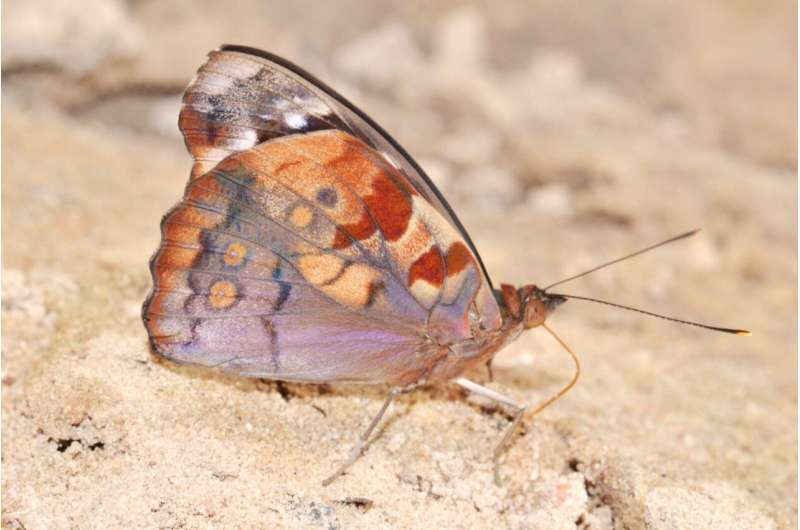This article has been reviewed according to Science X's editorial process and policies. Editors have highlighted the following attributes while ensuring the content's credibility:
fact-checked
proofread
Study identifies trend toward larger and fewer eyespot patterns on butterflies

Eye spots, color patterns that resemble the eyes of vertebrates, on butterfly wings are common in nature. A research team involving the Leibniz Institute for the Analysis of Biodiversity Change (LIB) and researchers in Mexico, Brazil and the U.S., have now identified a trend towards fewer and bigger eyespots in a group of tropical butterflies in a DNA-based study.
The research also challenges other scientists to answer further questions such as: Why does evolution lead to the loss of eyespots and the enlargement of just one or two? Does one large patch act as a more intimidating signal than several small ones?
The study, published in the journal Cladistics, documents the evolutionary relationships of a group of tropical butterflies based on DNA sequences and morphological traits. In the process, the researchers observed a change in the pattern of eyespots and confirmed the existence of a trend towards bigger and fewer eyespots.
"Eunica butterflies, a group that contains 40 species, are unique in featuring a wide variation in number and size of eyespots in the undersize of their wings," says Ivonne Garzón, a researcher at the UNAM university in Mexico City and lead author of the paper. In addition, the study analyzed a significantly larger amount of data from a representative sample of Eunica butterflies than previous studies.
The methods used do not offer an explanation for the morphological trend. However, the scientists hypothesize some causes. One possible explanation is that, in nature and under some conditions, a single large eyespot is more intimidating to potential predators (and thus more advantageous) than several smaller ones.
"We suspect that natural selection may lead to an increase in eyespot size on the one hand and the loss of several small eyespots on the other. The effect of the change varies depending on the habitat," concludes Karina Lucas da Silva-Brandão, section leader of butterflies and caddisflies at LIB. "Though the study is based on tropical butterfly groups, the conclusions could probably be applied to butterflies from other regions."
Eye spots are common color patterns present in the wings of butterflies and moths. They act by distracting or intimidating, thus serving primarily to ward off predators. In the butterfly group Eunica, variation in the size and number of eyespots is largely decoupled from variation in other morphological traits such as wing iridescence, sex-specific visual differences, or the union of male and female traits.
It is possible, the study suggests, that these traits not only evolved together (though independently from each other), but were also shaped by the geographic location of the species.
"The results of the study expand our understanding of nature and evolutionary processes," says Karina Lucas da Silva-Brandão. "Because of their attractiveness, lepidopterans are also known as 'flag species' because they draw attention to important issues such as species conservation and environmental protection."
More information: Ivonne J. Garzón‐Orduña et al, Wing pattern diversity in Eunica butterflies (Nymphalidae: Biblidinae): phylogenetic analysis implies decoupled adaptive trends in dorsal sexual dimorphism and ventral eyespot evolution, Cladistics (2023). DOI: 10.1111/cla.12556
Provided by Leibniz-Institut zur Analyse des Biodiversitätswandels




















